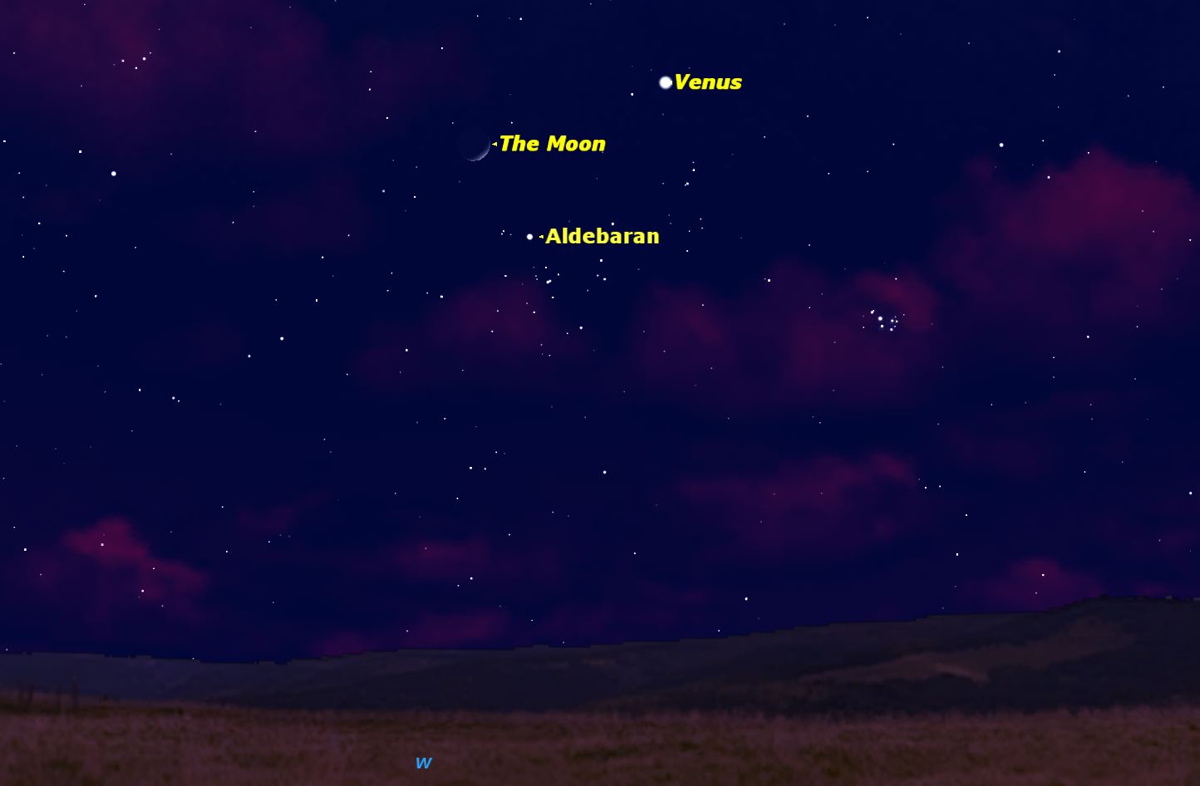
This evening will be another one of those special occasions when the two brightest objects in the night sky — the moon and a Venus — will get together and, weather permitting, will attract a lot of attention, even to those who normally do not spend much time in gazing up at the sky.
If your local weather is clear tonight (April 21), you're in for a celestial treat. Turn to face west about 45 minutes after sunset, during mid-twilight, and you should see a beautiful crescent moon and floating well off to its right is the dazzling evening star: the planet Venus.
And as the night gets darker, you might take note of another object, much dimmer than Venus, located to the lower right of the moon at roughly half the distance separating the moon and Venus. Shining with a distinct orange color, it's the 1st-magnitude star Aldebaran in the constellation of Taurus, the Bull. [Amazing Photos of Venus and the Moon]
Venus is the one object has been calling attention to itself as soon as the sun has slipped below the horizon. It currently dazzles in the western sky, about one-third of the way up from the horizon to the overhead point. Predictably, I've gotten quite a few inquiries about it in recent days. Typically they've gone something like this:
"I was out walking last week and was sure I saw a U.F.O. Was there anything unusual going on in the sky last week? Is there anything that could explain this 'sighting'?"
Venus is staying up late
Some folks are rather surprised when I tell them that Venus has been an evening object since mid-December. In at least two instances, I've had conversations with people who staunchly claimed that "Venus wasn't there just a week ago!" and that this is the first time that they've caught sight of it.
Of course, earlier in the year, Venus was considerably lower in the west-southwest sky, and setting much earlier in the evening (before 7 p.m. your local time). But now that we are more than a month into spring, with many states (save for Arizona and Hawaii) observing Daylight Saving Time, the viewing circumstances for Venus have changed for the better. Venus is now setting at around 11:15 p.m. local time for most observers.
Get the Space.com Newsletter
Breaking space news, the latest updates on rocket launches, skywatching events and more!
Venus coming attractions
But the best is yet to come!
On May 10, Venus will attain its highest declination: 26 degrees north of the celestial equator. Less than a month later, on June 6, it reaches its greatest eastern elongation (greatest angular distance east) of the sun of 45 degrees.
Roughly midway between these two extremes, for about two weeks beginning on May 17, Venus will be at the pinnacle of its current evening apparition. It will then be setting more than three and a half hours after local sunset. For New York City, for example, that corresponds to 11:44 p.m. EDT.
Interestingly, many astronomy books state flatly that you can't see Venus in the middle of the night. But thanks to Daylight Time, those places close to the western flank of a particular time zone will indeed be able to see Venus at the "witching hour." From Pittsburgh, Venus won't set until 12:07 a.m., while from Terre Haute, Indiana — near the boundary line between Eastern and Central time — Venus won't set until 12:33 a.m.!
Editor's Note: If you snap an amazing photo of Venus and the moon tonight and want to share it with Space.com for a story or gallery, send comments and images in to managing editor Tariq Malik at: spacephotos@space.com.
Joe Rao serves as an instructor and guest lecturer at New York's Hayden Planetarium. He writes about astronomy for Natural History magazine, the Farmer's Almanac and other publications, and he is also an on-camera meteorologist for News 12 Westchester, N.Y. Follow us @Spacedotcom, Facebook and Google+. Original article on Space.com.
Join our Space Forums to keep talking space on the latest missions, night sky and more! And if you have a news tip, correction or comment, let us know at: community@space.com.

Joe Rao is Space.com's skywatching columnist, as well as a veteran meteorologist and eclipse chaser who also serves as an instructor and guest lecturer at New York's Hayden Planetarium. He writes about astronomy for Natural History magazine, Sky & Telescope and other publications. Joe is an 8-time Emmy-nominated meteorologist who served the Putnam Valley region of New York for over 21 years. You can find him on Twitter and YouTube tracking lunar and solar eclipses, meteor showers and more. To find out Joe's latest project, visit him on Twitter.









